Media | Articles
At This Meticulous Texas Shop, There Are Two Ways to Skin a Jeep
A corner of the hobby born out of the mid-2000s, restomods just keep getting more popular. It’s easy to understand why. Daniel and Rachel van Doveren, owners of Vigilante 4×4 and JeepHeritage, call them “the perfect blend of vintage charm and contemporary performance.” On a recent visit to Vigilante’s Texas Hill Country shop, we got a chance to test that theory firsthand, comparing one of their recently finished restomods with a meticulously restored, mostly stock example.
Typically built on classics from the 1950s-70s, restomods (usually) combine tasteful vintage looks with modern drivetrains, suspension, and brakes underneath. You get many of the benefits of vintage car ownership (style, interior, driving experience, nostalgia) and fewer of the drawbacks (reliability, performance) all in one best-of-both-worlds package. For some, complete authenticity and “just as it left the factory” is still the only acceptable way of doing things, but the stigma around modifying an old car for usability has greatly diminished, and the restomod movement continues to grow.
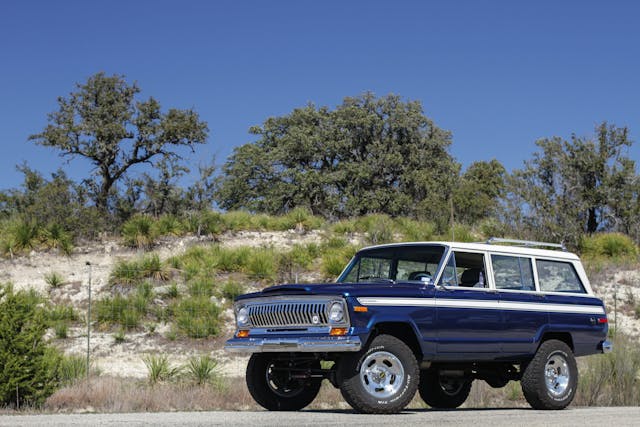
But not all restomods are created equal. The designation covers vintage Camaros that have been LS-swapped in a neighborhood garage all the way up to seven-figure, multi-year, show-winning builds. And while restomodding for speed and reliability makes sense in a sports or muscle car, what about an old Jeep?
The folks at Vigilante would argue that although nobody else is doing quite what they do, and certainly not at the same caliber, the appeal of a professionally and tastefully done restomod is just as real in a vintage truck or SUV as it is in anything else. If Icon is the restomod master of Ford Broncos and Singer of “reimagining” 964 Porsches, Vigilante is where you go for a thoroughly reworked, high-end, detail-oriented build of your vintage Jeep. Specifically, the SJ-platform Jeeps, like the original Cherokee, Wagoneer, and Gladiator/J-Series pickups.
Their sister brand JeepHeritage, meanwhile, focuses on the resto-ration rather than the resto-modification of Jeep’s full-size favorites. Although they exclusively performed factory-correct restorations at first, the momentum has completely shifted since starting Vigilante 4×4, and Daniel and Rachel say the vast majority of their work currently is on the restomod side. To get a clue as to why that is, how the restomods drive compared to stock, and why these builds get so expensive (a Vigilante build starts at $295K, for a Jeep), we decided to check out their facility and a couple of their recent builds.
Marketplace
Buy and sell classics with confidence

Daniel van Doveren is an absolute Jeep freak, which is to be expected. “I’ve never owned any type of car that isn’t a Jeep,” he says. But he’s not a textbook Jeep freak, either. He grew up in Belgium—not exactly truck-central—but there were enough old Jeeps running around to catch his interest, and he started fixing them up in his teens. Eventually, he started finding Jeeps for sale online in the States, making the trip across the Atlantic, and driving them to port to ship home, and fixing the things that inevitably broke along the way. One of his early builds caught the attention of a European Jeep exec who bought it, and it was during one of his Stateside trips that he met Rachel before a concert in Houston.
They stayed in touch. Then she boldly accepted an invitation to tag along while Daniel drove an old Jeep from Kentucky to Texas. The trip must have gone well because Daniel moved to the U.S., they got married, and then started a business together. After a few years running JeepHeritage and performing top-quality restorations on SJ-platform Jeeps (a rare skill in that particular corner of the collector vehicle hobby), they saw another opportunity.


Not everybody knows how to use or maintain a vintage automobile, which is one of the main appeals of a restomod. They also noticed the growing world of high-end, specialty restomod builders that focus on one or two platforms. They’ll readily admit they found inspiration in what Icon 4×4 has done with first-gen Ford Broncos, “but nobody was doing that with Jeeps,” Daniels says. With that gap in the market in mind, and with countless hours soaking up brand knowledge and fixing Jeeps, they started Vigilante 4×4 in 2021. Since then, customer demand has seen them shift most of their attention and effort to the restomod side of the business. So far, they’ve completed 88 projects and currently do about eight builds per year, but are looking to ramp up to 12. Which is a good idea—their wait list currently sits at three years.
“We don’t really have a typical customer,” says Rachel. “They range from die-hard Jeep people to someone who just happened to see one of the finished builds and fell in love with it.” One Cherokee currently being assembled is on its way to a woman who wants a classic, but also wants a reliable and safe way to drive her kids around. Are there cheaper ways to do the school run? Sure, but if you’re going to spend that kind of money, it’s a way cooler mom-flex than a Cullinan or G-Wagen.

Before starting each build, Vigilante 4×4 speaks with the client about their tastes and potential uses for the vehicle, then guides them through the selection of drivetrain, interior features, etc. Sometimes the donor Jeep comes from the client; other times it comes from Vigilante’s own inventory of Jeeps and parts. Daniel says that, thanks to their reputation in the Jeep community, people call constantly looking to offload unwanted old Jeeps.
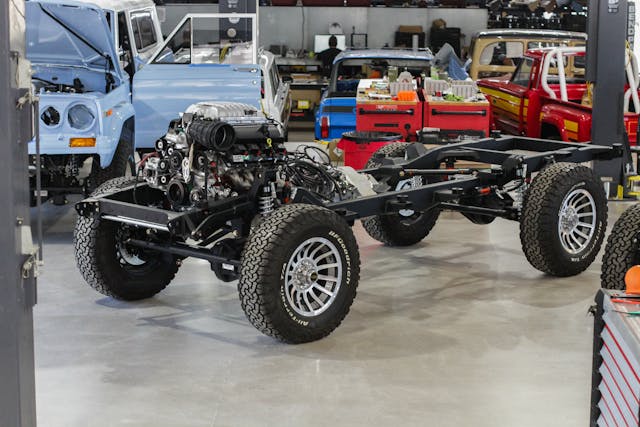

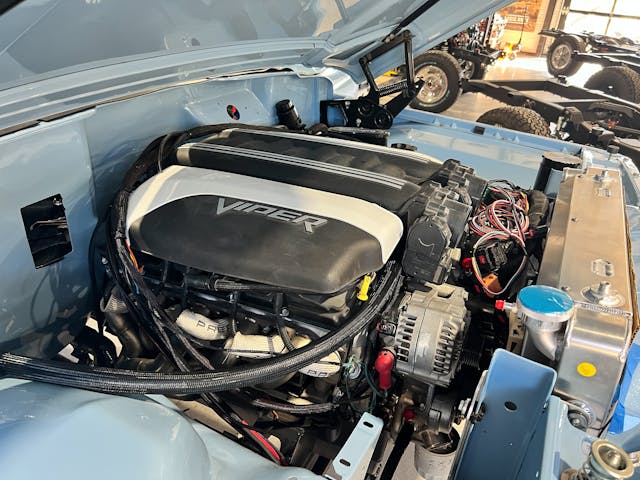
Then starts the many-months-long process of transforming a vintage Cherokee or Wagoneer into a six-figure custom. And it is quite the process. Vigilante designed and builds its own beefy custom chassis that fits right to the vintage Jeep bodies but is also strong enough to handle up to 1000 horsepower and integrate with all the modern hardware. Dana 44 front and 60 rear axles turn the wheels, and the leaf springs of old are gone, replaced by Fox shocks and coil springs up front, with a multi-link setup in rear. Keeping it in the Mopar family, Vigilante only uses Chrysler engines under the hood. Most get a Mopar 392-cubic inch Hemi crate engine with 485 hp, which seems like plenty, but the Vigilante chassis will handle a Hellcat Redeye engine, and at least one customer has specified a Viper V-10. Vigilantes can apparently also be serviced at any dealership, just like a new Durango SRT.
The body, meanwhile, gets shipped to Europe for finishing, but otherwise Vigilante is a nearly soup-to-nuts operation, and it’s in the details where the work gets truly impressive. In fixing up Jeeps for most of his life, Daniel knows where the problem areas are, and shares that “there was so much room for improvement in a lot of the original designs.” Some of their solutions are obvious, like the bracketry Vigilante came up with to keep batteries from coming loose while driving.
Others aren’t obvious at all. On an old Cherokee, for example, the original door handles were a bit too close to the body to get fingers comfortably around, so Vigilante designed an extender that pushes them out just enough for easier operation. Original Jeep mirrors tended to rattle, so now they’re machined and fit tighter, with the Vigilante logo subtly stamped into the end of the stalk. Vintage manual window winders can look nice, but cranking them isn’t exactly fun, so Vigilante devised a power window setup that keeps the old winder but raises or lowers the window by flicking it up or down. I wouldn’t have noticed any of these things without having them pointed out, but that’s why they call it attention to detail.
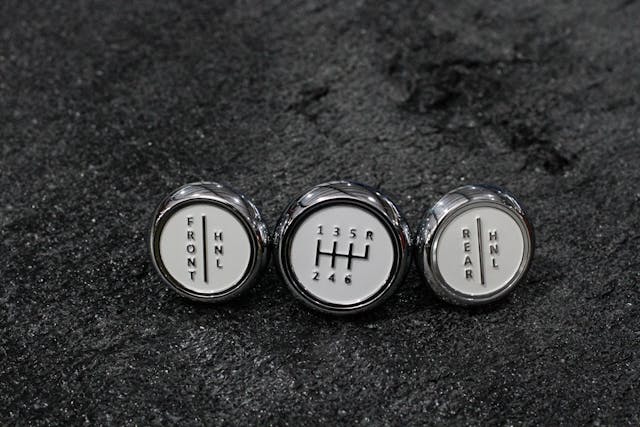
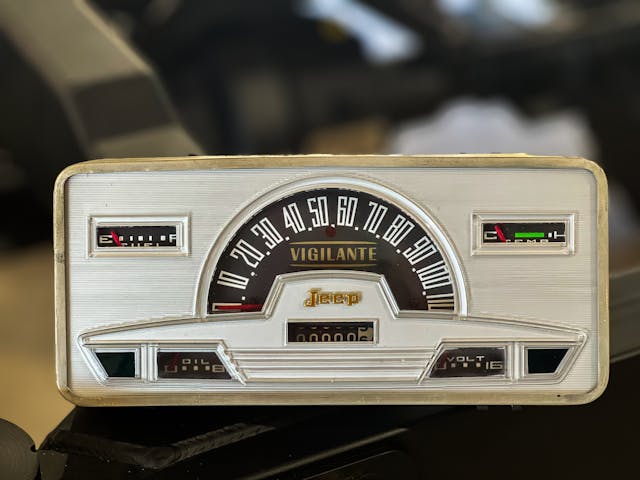
Vigilante also strikes the right balance of offering real improvements while staying true to heritage and having the right look. The steering ratio on the restomods is tighter, so the steering wheel is smaller, but it looks just like a shrunk-down version of the original. The wheels, meanwhile, need to be larger than original to clear the brakes, so they’re scaled-up versions of the originals that look just right in their finish and proportions. No giant, tacky chrome rims here.
Gauges are upgraded but original-looking as well, and the original radio remains in place, but has been rewired to connect to Bluetooth. Shift knobs show the gate pattern of a modern six-speed, but do so in the original Jeep style. The upholstery is of a higher quality than Jeep used, but Vigilante is still careful to get the color and texture right. Many of the improvements and additions that Vigilante makes are also possible thanks to CAD, 3D scanning and 3D printing, which was all far less accessible technology even just a decade ago.

It’s all deeply impressive stuff, and that sky-high price tag is starting to make more sense. But how does this long list of upgrades really compare to Jeeps as they would have rolled out of the factory in the 1960s, 1970s, and 1980s? To find out, I drove a stock 1980 Cherokee, with very much of-the-period Bordeaux Metallic paint and Golden Hawk graphics, back to back with a 1977 Cherokee four-door that Vigilante has made all-new from the skin down.
The Golden Hawk has gotten JeepHeritage’s Stage Two build, which means “stock platform, impeccable restoration with a couple of upgrades,” including four-wheel disc brakes, tighter steering and a plusher interior, in this instance. It’s nevertheless much as it would have been in 1980, with a 360-cubic inch AMC V-8 and three-speed auto providing motivation. But because it has also had six figures worth of JeepHeritage’s attention, it feels tight as a drum, and clean. There’s no denying you’re sitting in a 40-plus-year-old truck by the look of everything, but conspicuously absent are the squeaks, rattles and funny smells I’m used to experiencing when sitting in a rig of this vintage.
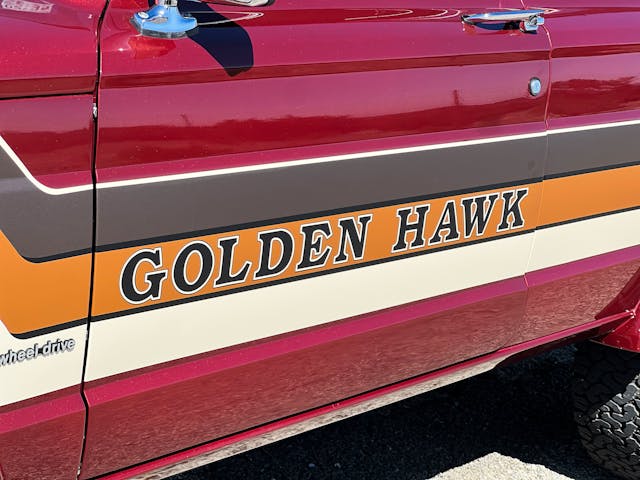


What is familiar is the lazy sound of a Malaise Era V-8 on startup and its gentle waft forward after the also-familiar engagement of an old column-shift automatic. Aside from V-8 burble, there aren’t many other noises coming from the Golden Hawk. It feels like a fresh, well-screwed-together restoration, but it still drives like a Jeep from 1980. Vague steering and a feeling of disconnection from the road, compared to a car, are to be expected. As is the nudge from a crosswind since, after all, the body has the shape (and in this case, color) of a big brick. The AMC 360 was rated at 175 hp when new and it does move the Golden Hawk up and down the Hill Country without running out of steam, but also without real urgency. Nobody gets nostalgic for old brakes, so the big discs are a welcome addition here, taking nothing away from the old school sensations while providing a modern-feeling stopping distance when you need it. This would make a great vintage cruiser for the lake, beach, or slow Sunday drive.

The 1977 Cherokee four-door, meanwhile, is a different animal under similar skin. It has gotten the full Vigilante treatment, which means new chassis, suspension, and 392 Hemi under the old school body. At the twist of an old key, it fires up with a modern growl. After setting off, moving through a few bends and punching it down a few straight bits, perhaps the most surprising thing is how similar it feels to the stock Cherokee. And this is a pleasant surprise. When you hear something has a completely new chassis and drivetrain underneath, part of you expects it to feel like a twenty-first century skateboard dressed in old sheetmetal. Here, though, it just feels like a much tighter, more responsive, and completely dialed in version of the Golden Hawk, on some steroids. If you put on a blindfold and drove it you’d still know you were driving a classic.



That said, the modern power and suspension make everything a lot more exciting. Although there’s no arguing with physics and this is still a tall body-on-frame truck, the steering is far more communicative and precise than the Golden Hawk. So is the ride over bumps and through corners, thanks to twenty-first century suspension. The 392 engine offers plenty of punch and feels fast, but the Cherokee still feels planted and controlled under hard acceleration. It’s not scary, just entertaining. I can’t say the same for one of the Hellcat-powered Vigilantes, but I didn’t drive one of those.
A six-speed manual is a surprisingly popular option for Vigilante 4×4’s customers. Indeed, the majority opt for it. But you don’t need to row your own gears to have fun in this thing. Just like the mostly stock Golden Eagle, this would also be a great way to get around on summer adventures, but each trip would be a lot more entertaining.
Does it feel like a $300K-plus vehicle? After a day, no. Not really. But, after let’s say a week of appreciating all the clever details, the huge list of little improvements and the levels of care that go into each one, I’d probably change my mind.
After seeing Vigilante Jeeps and similar-quality builds up close, it looks like these top-tier, professional restomods can justify their sky-high price tags for a few reasons. First and most obvious is the quality: The fit and finish is superb, everything feels premium and well thought out, and no corner-cutting is visible on a closer inspection. Second is the attention to detail and thoroughness of the improvements over stock, not just in performance and reliability but also in comfort, convenience, usability, and style. Third is striking the right balance between thorough upgrades and staying true to the original vehicle’s heritage, which really isn’t easy to do. Somehow, Vigilante 4×4 manages to do all three.
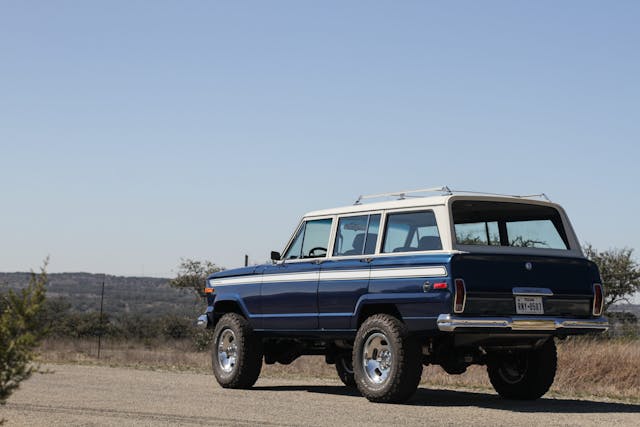
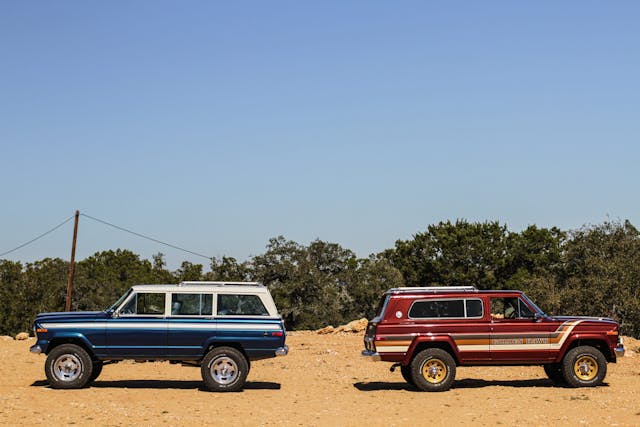
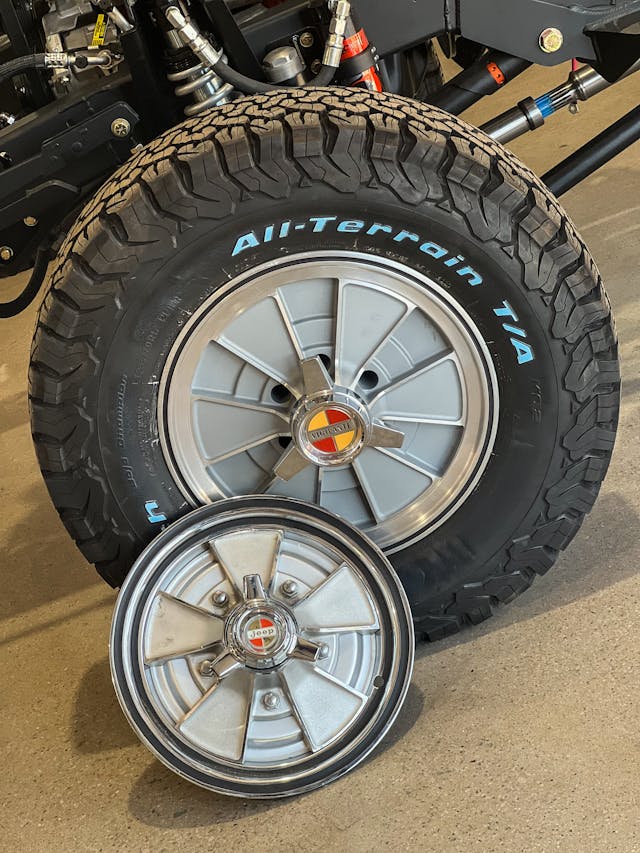























Crazy money again, but their products do look good. Viper motor and a Hellcat floating around in one of these is madness. 392 seems like the right choice for this vehicle.
The only way to skin a jeep is to throw it in a crusher. I bought a 1980 brand new Cherokee in my early twenties and to this day it was the worst thing I have ever purchased. If I would have invested in Blockbuster Video rather than buying that junk I would be a rich man today.
Well there you have it from the expert. They might as well just shut their doors and declare bankruptcy.
It’s a pity you had a bad experience, but you shouldn’t generalize about it, which doesn’t help in this context.
Interesting and informative article. While I favor and own a couple older Jeeps (XJ and MJ), it’s seems there are some that have way more discretionary cash or maybe way more desire to purchase Jeeps such as these. The builds are impressive and the skills are admirable. However, for the prices listed here it better have a roof with 3 bedrooms and 2 baths on an acre or two of land. Not just 4 wheel drive and new innards.
A buyer of one of these ultra custom and ultra pricey $300,000 resto-mods was asked a direct question: What do you think your resale value will be in 10 years?
His answer came immediately, and without hesitation: “I don’t care.”
You see, if you don’t care, you can do any manner of silly things with your money. Or your life.
The body gets shipped to Europe for finishing?!?! Huh? Would have loved to hear a few more details as to why thar happens.
I was wondering the same thing.
“Europe” probably means eastern Europe, where wage rates are lower and regulations on paints & solvents are more relaxed. Perhaps there are savings in doing things that way, even after the shipping expense.
It’s historical and has nothing to do with Eastern Europe and your explanations. Before coming to the U.S., the manufacturer was based in Belgium, with some of the world’s leading steelworkers, and this collaboration has remained, simply that.
Devised a power window setup? Yeah, that’s a street rod trick that’s been around for decades.
Exactly, we threw out the original configuration, which was always breaking, to review the strength of the mechanism.
Really cool story. I would love to have a late 70s Cherokee or J10 Honcho with a 392 Hemi and all the modern upgrades. But, $300K is out of my league.
Three years out for $300k Jeeps. Right.
European coach work on a Wagoneer. Right.
Custom power windows. Right.
“Does it feel like a $300K-plus vehicle? After a day, no”. Right.
“perhaps the most surprising thing is how similar it feels to the stock Cherokee”. Right.
The only place you will see a $300k Jeep or a $300k Bronco is at the SEMA show.
Once again, a hasty conclusion: they completely rebuild the vehicle, they meticulously make it reliable, they don’t use tar or hide things with putty and they don’t use standard components, only originals or specially remanufactured ones. The vehicle looks like the original because it’s meant to. They look for a certain finesse in the result, nothing bling bling. All this takes 36 months to restore, and what’s more, you can simply add up the components they use, and that will give you an idea of the price. By the way, they were at the SEMA show a few years ago.
No hard feelings